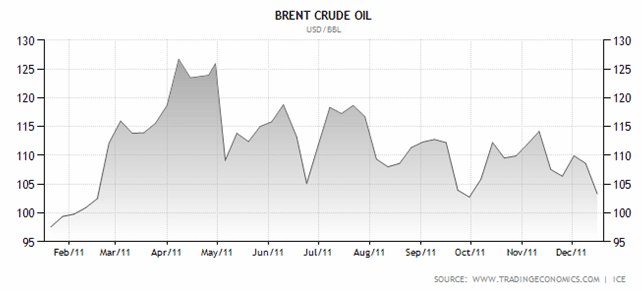Oil Volatility in 2011
Oil prices on the Nymex started the year at US$88, persisted at that level till it crossed the 100 dollar mark in March, and remained at US$112 till end of April, rising on reaction to Libyan leader Gaddafi’s strike back as fighting in Libya intensified, supported by positive jobs data from USA. Prices flitted at US$100 in May and then dipped to hover around US$90-98 until July on gloomy U.S. inflation report, renewed Eurozone worries. Oil prices dipped below US$90 in August amid stock market volatility and the first-ever downgrade of USA’s credit rating. Fears that US is heading for another recession triggered fears of a drop in oil demand that brought down prices to US$76 levels. In an unprecedented move, credit rating agency Standard & Poor's (S&P) downgraded credit rating of the US federal government from AAA to AA+ on August 5, 2011. This reflected the inability of political leaders to come up with a long-term plan to reduce the federal budget deficit. Oil prices stayed at August levels in September and most of October. In November and December, oil hovered between US$90 and 100. In December, the UN nuclear regulator IAEA detailed evidence that Iran is developing technology needed to build a nuclear weapon, triggering USA to impose additional sanctions against Iran's petrochemical industry. The existing sanctions by US against Iran prohibit American companies from doing business with Iran, and the new measures aim to block foreign companies from doing business with Iran's petrochemical industry by threatening them with being banned from U.S. markets. Iran insists its nuclear program is peaceful and has called the U.N. watchdog's report "unbalanced" and "politically motivated."

Speculations that global economic growth could slow and curb fuel demand amid rising supplies have caused volatile oil prices to continue to weaken. Global demand is expected to slow down due to an estimated slowdown in economic growth in China, the fiscal crisis in Europe and deteriorating demand in USA. Brent Crude Oil futures contracts rallied 18 dollars or 20.7% during the last 12 months.
The Eurozone Crisis and its Impact on the World
The current Eurozone crisis started unfolding around February 2010 when Greece outlined an austerity program to trim a 2009 budget deficit of 12.7% to GDP, followed by market concerns about other heavily indebted countries like Portugal, Ireland, Italy and Spain. In February 2011, Eurozone ministers set up a permanent bailout fund, called the European Stability Mechanism, worth about £500 bln. In August 2011, European Central Bank committed to buying Italian and Spanish Government bonds to bring down borrowing costs. Italy passed a 50 bln euro austerity budget. In October 2011, a general strike brought Greece to a standstill, Euro ministers agreed to a Greek bailout. In November 2011, Lucas Papademos replaced George Papandreou as Greek Prime Minister. The European Commission predicted that economic growth in the eurozone will come "to a virtual standstill" in H2-2011, growing just 0.2% and putting more pressure on countries' budgets. The consequences of a possible Eurozone break-up would be severe, with exiting countries suffering sharp initial falls in GDP and massive financial disruption which would plunge much of the world, including the US, back into recession.
The US, growing at a snail's pace since 2010, faces considerable downside risks from the Eurozone crisis. For the first six months of 2011, the US economy grew at an annual rate of only 0.9%, which improved to 2% in Q3, followed by a 3% growth rate forecast for Q4. A positive trend pushed down the unemployment rate to 8.6% from 9%, where it had lingered for months. It is apparent that the US economy is ending 2011 better than how it started. The year is ending a new uptrend in the US dollar mainly due to the ongoing fiscal concerns in Europe.
European Plastics Industry
According to AMI's recently published European Plastics Industry Report 2011, most sectors reported continuing growth in the H1-2011, by mid-year signs of a slowdown were beginning to emerge and full year is expected to pan out at about half the rate achieved in 2010 and only slightly ahead of GDP. The European market still has some way to go to regain all the volumes lost from the 2007 peak when the market reached over 41 mln tons. The recovery in demand over the past two years has also at times been challenged by issues around availability of raw materials and pricing volatility in addition to polymer prices rising on an almost constant basis from December 2009 through to June 2011, because of increasing feedstock costs. Whereas a few years ago Germany was seen as a mature, slow growing market with its plastics processing industry moving into Central Europe, the strength of its manufacturing industry and economy is now the engine for growth in Western and Central Europe. The bright prospects expected for Europe's Southern countries, Spain, Portugal, Italy and Greece, have now all faded away in the face of bursting asset bubbles and massive government deficits. Per capita use of polymer in 2011 stands at just short of 74 kg/head compared with over 82 kg/head in 2007. UK now has the lowest level of per capita demand for thermoplastics in Western Europe highlighting the decline in plastics processing that has occurred there over the past decade. The Benelux region continues to have the largest per capita consumption largely because of the presence of some major export-oriented processors in plastics film, fibre, compounds and masterbatch.
Petrochemical producers are now focusing on attaining both economies of scale and geographic expansion to gain a competitive advantage. Petrochem producers from the developed economies are seeking to create a presence in demand-rich geographies and are diversifying their portfolios to achieve higher growth rates. They are setting up joint ventures with Asian or Middle Eastern companies to sustain their profit margin.
| |